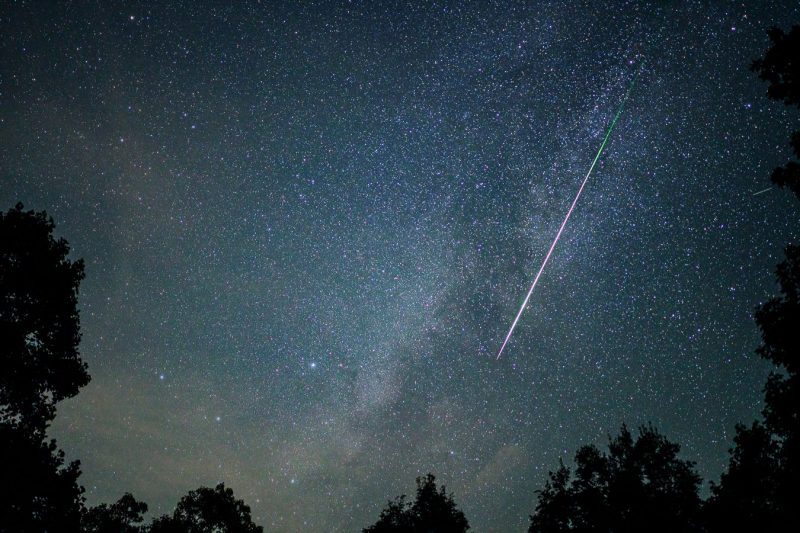
Peak dates are primarily from American Meteor Society.
January 2-3, 2022, night, Quadrantids
In 2022, watch for the Quadrantids after midnight and before dawn on January 3. The moon will be new, making for great meteor-observing conditions. The Quadrantids can produce over 100 meteors per hour in a moonless sky, and this year is such a time. This is great, because the narrow peak of this shower lasts only about six hours, although the range of Quarantid meteor activity is from December 26, 2021, to January 16, 2022. The radiant point is in the part of the sky that used to be considered the constellation Quadrans Muralis, the Mural Quadrant. The radiant is near the famous Big Dipper asterism (see chart here). In January, it’s in the north-northeastern sky after midnight and highest up before dawn. Because the radiant is fairly far to the north on the sky’s dome, meteor numbers tend to be greater at northerly latitudes in the Northern Hemisphere.
Read more: All you need to know about Quadrantid meteors
EarthSky lunar calendars are back in stock! We’re guaranteed to sell out – get one while you can.

April 21-22, 2022, night, Lyrids
In 2022, we expect peak viewing in the dark hours before the last quarter moon rises. The best time to watch is between sunset on April 21 and moonrise in the early morning. The Lyrid meteor shower – April’s shooting stars – lasts from about April 15 to 29. About 10 to 15 meteors per hour can be expected around the shower’s peak, in a dark sky. The Lyrids are known for uncommon surges that can sometimes bring the rate up to 100 per hour. Those rare outbursts aren’t easy to predict, but they’re one of the reasons the tantalizing Lyrids are worth checking out. The radiant for this shower is near the bright star Vega in the constellation Lyra (chart here). The radiant rises in the northeast at about 10 p.m. on April evenings.
Read more: All you need to know about Lyrid meteors
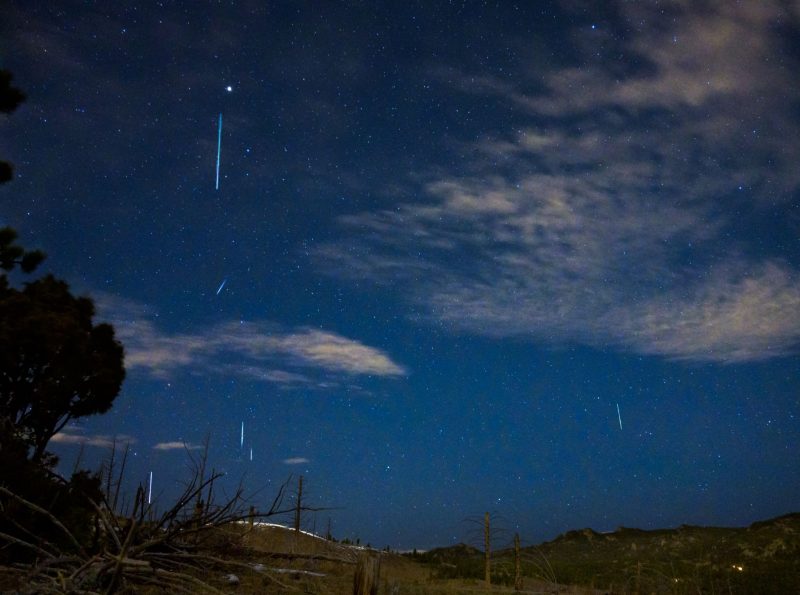
May 5, 2022, before dawn, Eta Aquariids
In 2022, the most Eta Aquariid meteors will likely rain down in the hour or two before dawn on May 5. The waxing crescent moon is very new (only 15% illuminated) and will gracefully set around midnight to give you perfect darkness. The broad peak to this shower means that some meteors may fly for a few days before and after the predicted optimal date. The Eta Aquariids have a somewhat broad maximum. You can watch the shower the day before and after the predicted peak morning. The shower favors the Southern Hemisphere and is often that hemisphere’s best meteor shower of the year. Its radiant is near the star Eta Aquarii in the constellation Aquarius the Water Bearer (chart here). The radiant comes over the eastern horizon at about 4 a.m. local time; that is the time at all locations across the globe. For that reason, you’ll want to watch this shower in the hour or two before dawn, no matter where you are on Earth. In the southern half of the U.S., 10 to 20 meteors per hour might be visible in years when you have a dark sky – like 2022. Farther south – at latitudes in the Southern Hemisphere – you might see two to three times that number on a dark, moonless night. Meanwhile, at northerly latitudes – like those in the northern U.S. and Canada, or northern Europe – meteor numbers are lower for this shower.
Read more: All you need to know about Eta Aquariid meteors

Late July 2022, before dawn, Delta Aquariids
At this shower’s peak on or near July 29-30, 2022, the rather faint Delta Aquariid meteors will fall most abundantly in the pre-dawn hours. The moon will be extremely new during this time, making for nice and dark observing conditions. Like the Eta Aquariids in May, the Delta Aquariid meteor shower in July favors the Southern Hemisphere and tropical latitudes in the Northern Hemisphere. It’s well viewed from latitudes like the southern U.S. These faint meteors appear to radiate from near the star Skat, aka Delta Aquarii, in the constellation Aquarius the Water Bearer. The maximum hourly rate can reach 15 to 20 meteors in a dark sky. The nominal peak is around July 29-30, but, unlike many meteor showers, the Delta Aquariids lack a very definite peak. Instead, these medium-speed meteors ramble along fairly steadily throughout late July and early August. You’ll see plenty of Delta Aquariids mixed in with Perseids, if you’re watching in early August, and from a southerly latitude. An hour or two before dawn is usually the best time to watch the Delta Aquariids.
Read more: All you need to know about Delta Aquariid meteors

Late evening to dawn on August 11-12, 2022, Perseids
Unlike 2021, 2022 is not fully as great a year for the Perseids. The full moon will be up all night long, illuminating your sky. However, although the predicted peak falls during the night of August 11-12, it has a long range: from July 14 to September 1. So, you can start watching for these meteors in early August morning hours, when the moon is waxing and will set before the night is over. You can also look after the peak in August, after sunset, as the moon rises later and later each night. The Perseid meteor shower is perhaps the most beloved meteor shower of the year for the Northern Hemisphere. It’s a rich meteor shower, and it’s steady. These swift and bright meteors radiate from a point in the constellation Perseus the Hero. As with all meteor shower radiant points, you don’t need to know Perseus to watch the shower. Instead, the meteors appear in all parts of the sky. These meteors frequently leave persistent trains. Perseid meteors tend to strengthen in number as late night deepens into midnight. The shower typically produces the most meteors in the wee hours before dawn.
Read more: All you need to know about Perseid meteors

October 8, 2022, after nightfall, Draconids
In 2022, the moon is just one day from full and will drown many Draconid meteors. But, you might catch some on days around the peak, and then especially the days after, before the moon has risen in the evening time. The radiant point for the Draconid meteor shower almost coincides with the head of the constellation Draco the Dragon in the northern sky. That’s why you can view the Draconids best from the Northern Hemisphere. The Draconid shower is a real oddity, in that the radiant point stands highest in the sky as darkness falls. That means that, unlike many meteor showers, more Draconids are likely to fly in the evening hours than in the morning hours after midnight. This shower is usually a sleeper, producing only a handful of languid meteors per hour in most years. But watch out if the Dragon awakes! In rare instances, fiery Draco has been known to spew forth many hundreds of meteors in a single hour.
Read more: All you need to know about Draconid meteors
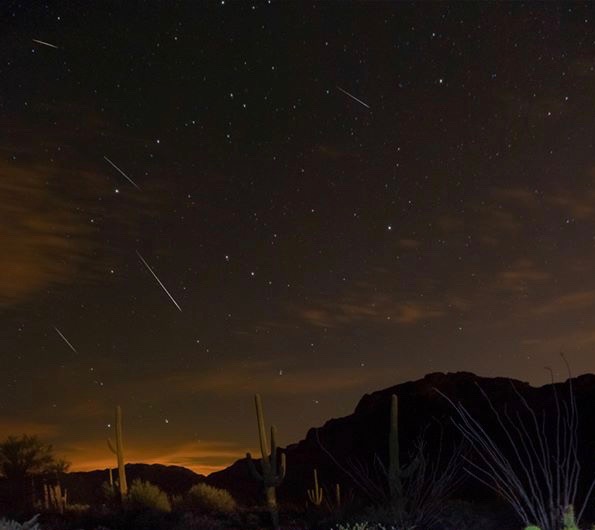
October 21, 2022, before dawn, Orionids
While last years Orionids were mainly drowned out by the moon, 2022’s Orionid shower should provide better opportunities. The moon is a thin waning crescent that doesn’t rise until the early morning hours. Try watching for these meteors in the wee hours before dawn on October 21 (even after moonrise, the moon won’t interfere a lot with the view). On a dark, moonless night, the Orionids exhibit a maximum of about 10 to 20 meteors per hour. More meteors tend to fly after midnight, and the Orionids are typically at their best in the wee hours before dawn. These fast-moving meteors occasionally leave persistent trains. The Orionids sometimes produce bright fireballs, which might be able to overcome a moonlit glare. If you trace these meteors backward, they seem to radiate from the Club of the famous constellation Orion the Hunter.
Read more: Everything you need to know Orionid meteors

Late night November 4 until dawn November 5, 2022, the Southern Taurids
The meteoroid streams that feed the Southern (and Northern) Taurids are very spread out and diffuse. Thus the Taurids are extremely long-lasting (September 28 to December 2 in 2022) but usually don’t offer more than about five meteors per hour. That is true even on their peak nights. The Taurids are, however, well known for having a high percentage of fireballs, or exceptionally bright meteors. Plus, the two Taurid showers – Southern and Northern – augment each other. In 2022, the expected peak night of the South Taurid shower is that of November 4-5, but the waxing gibbous moon will be bright at 87% illumination. Peak viewing will thus be in the pre-dawn morning of November 5, just after the moon has set at 3 a.m. The South and North Taurid meteors continue to rain down throughout the following week, but the moon will keep getting fuller, so the best viewing is during mornings before the peak rather than after.
November 11 to 12, 2022, the Northern Taurids
Like the South Taurids, the North Taurids meteor shower is long-lasting (October 13 – December 2 in 2022) but modest, and the peak number is forecast at about five meteors per hour. The North and South Taurids combine to provide a nice sprinkling of meteors throughout October and November. Typically, you see the maximum numbers at or around midnight, when Taurus the Bull is highest in the sky. Taurid meteors tend to be slow-moving but sometimes very bright. In 2022, just as for the South Taurids, the bright moon interferes with your viewing. The meteor peak takes place just after full moon and the waning gibbous moon rises a bit later every night, providing dark skies only a few hours after nightfall.
Note that, although both these Taurid showers – Southern and Northern – are not very noticeable, as we mentioned they sometimes provide an increase in the number of fireball meteors. The American Meteor Society said:
There seems to be a seven year periodicity with these fireballs. 2008 and 2015 both produced remarkable fireball activity. 2022 may be the next opportunity.

November 17-18, 2022, evening till just after midnight, the Leonids
In 2022, the expected peak night of the Leonids is from November 17 until dawn November 18. The waning crescent moon doesn’t rise until about 2 a.m., so the best peak viewing is just before that time. The famous Leonid meteor shower produced one of the greatest meteor storms in living memory. Rates were as high as thousands of meteors per minute during a 15-minute span on the morning of November 17, 1966. On that beautiful night in 1966, Leonid meteors did, briefly, fall like rain. They streamed from a single point in the sky – their radiant point – in the constellation Leo the Lion. Some who witnessed the 1966 meteor storm had a strong impression of Earth moving through space, fording the meteor stream. Leonid meteor storms sometimes recur in cycles of 33 to 34 years. But the Leonids around the turn of the century – while wonderful for many observers – did not match the shower of 1966. And, in most years, the Lion whimpers rather than roars. In a typical year, you’ll see a maximum of perhaps 10-15 meteors per hour on a dark night. Like many meteor showers, the Leonids ordinarily pick up steam after midnight and display the greatest meteor numbers just before dawn, for all points on the globe.
Read more: All you need to know about Leonid meteors
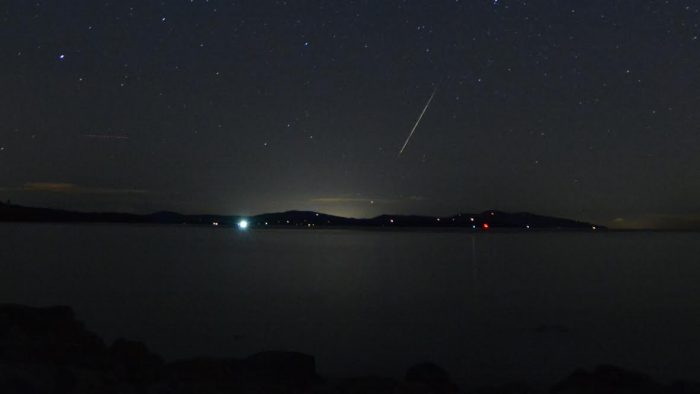
December 13-14, 2022, before midnight, Geminids
Just like last year, the peak night of the 2022 Geminid shower must endure many hours of moonlight. But this time the moon is waning, not waxing. The moon doesn’t rise until just before midnight, so the evening sky is dark and thus the best time to look for meteors. The brighter Geminids might overcome the moonlight later in the night. So you can watch the usually reliable and prolific Geminid meteor shower from evening December 13, with the best views probably just before or around midnight. We can’t guarantee what you’ll see, but you might see something! The Geminid meteor shower radiates from near the bright stars Castor and Pollux in the constellation Gemini the Twins. This is one of the Northern Hemisphere’s best showers (and is still visible, at lower rates, in the Southern Hemisphere). The meteors are plentiful, rivaling the August Perseids. They are often bold, white and bright. On a dark night, you can often catch 50 or more meteors per hour in a dark, moonless sky. The greatest number of meteors typically fall in the wee hours after midnight, centered around 2 a.m. local time (the time on your clock no matter where you are on Earth). That’s when the radiant point is highest in your local sky.
Read more: All you need to know about Geminid meteors

December 22, 2022, before dawn, the Ursids
A faint waning crescent moon at only 3% illumination provides excellent viewing conditions for the 2022 Ursids. This low-key meteor shower is somewhat overlooked due to the season and that its rates are much lower than the popular Geminids, peaking just a week before. Ursids range from December 13 to 24, so some may intermingle with the peak of the Geminids. The Ursids usually peak around the December solstice, perhaps offering five to 10 meteors per hour during the predawn hours in a dark sky.
Read more: Ursid meteors peak around December solstice
Meteor shower guide: Find a dark sky
Here’s the first thing – the main thing – you need to know to become as proficient as the experts at watching meteors. That is, to watch meteors, you need a dark sky. It’s possible to catch a meteor or two or even more from the suburbs. But, to experience a true meteor shower – where you might see several meteors each minute – avoid city lights. EarthSky’s Best Places to Stargaze page shows dark locations worldwide. Once you choose your dark area, you can watch from many sorts of areas: a rural backyard or deck, the hood of your car, the side of a road. State parks and national parks are good bets, but be sure they have a wide open viewing area, for example, a field. You don’t want to find yourself stuck in a forest on meteor night. An EarthSky friend, veteran meteor-watcher and astrophotographer Sergio Garcia Rill, also offers this specific advice:
… you might want to give it a try but don’t know where to go. Well, in planning my night photoshoots I use a variety of apps and web pages to know how dark the sky is in a certain location, the weather forecast, and how the night sky will look.
Suggested apps and websites
Best Places to Stargaze, from EarthSky
Find a Dark Sky Place, from the International Dark Sky Association
Heavens-Above: Satellite predictions customized to your location
Stellarium Online: Star maps customized to your location
Dark Site Finder, from astrophotographer Kevin Palmer/
EarthSky’s top 10 tips for meteor-watchers
What to bring
You don’t need special equipment to watch a meteor shower. But you do want to be comfortable. Consider a blanket or reclining lawn chair, and a thermos with a hot drink. Be sure to dress warmly enough, even in spring or summer, especially in the hours before dawn. Binoculars are fun to have. You won’t need them for watching the meteor shower, but, especially if you have a dark sky, you might not be able to resist pointing them at the starry sky.
Meteor showers are part of nature. They’re inherently unpredictable. Your best bet is to go outside at the times we suggest, and plan to spend at least an hour, if not a whole night, reclining comfortably while looking up at the sky. Also remember that meteor showers typically don’t just happen on one night. They span a range of dates. So the morning before or after a shower’s peak are often worthwhile times to watch.
Remember …
… Meteor showers are like fishing. You go, you enjoy nature … and sometimes you catch something.
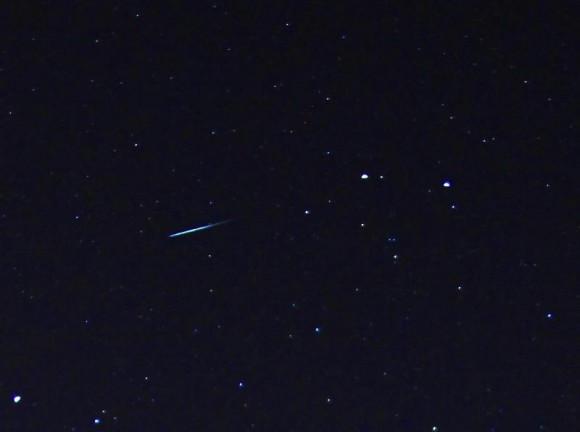
Bottom line: Look here for information about all the major meteor showers between now and the year’s end. There are some good ones!
Via The American Meteor Society Calendar 2021-2022
The post EarthSky’s meteor shower guide for 2022 first appeared on EarthSky.
0 Commentaires